You can transform rocky hillsides, enrich wetland borders, and revitalize urban spaces with New York’s remarkable native plants. These resilient species don’t just survive the Empire State’s challenging conditions, they actually thrive in everything from Zone 3’s bitter winters to Zone 7’s humid summers. Wild Bergamot blooms for eight weeks straight, while Black-Eyed Susan self-seeds across poor soils that would kill most garden favorites. But here’s what most gardeners don’t realize about timing their plantings.
Contents
- 1 New York’s Soil and Weather
- 2 Colorful Wildflowers for New York
- 3 New York’s Best Native Trees
- 4 Native Shrubs for Wildlife Habitat
- 5 Selecting the Right Native Plants for Your Garden
- 6 Frequently Asked Questions
- 6.1 Where Can I Purchase Native Plants in New York?
- 6.2 How Much Do Native Plants Typically Cost Compared to Non-Native Varieties?
- 6.3 What’s the Best Time of Year to Plant Native Species?
- 6.4 Do Native Plants Require Special Fertilizers or Soil Amendments?
- 6.5 How Long Do Native Plants Take to Establish in New Gardens?
New York’s Soil and Weather
Before you choose your native plants, you’ll need to understand New York’s incredibly diverse soil landscape. With over 561 named soil series covering the state, you’re dealing with everything from fertile glacial till to sandy coastal soils. The prominent Honeoye series alone spans 500,000 acres across 15 counties, while lime-rich glacial till creates a productive belt stretching into the Hudson Valley.
Climate adaptation becomes essential since northern areas experience cooler, wetter conditions while downstate regions stay milder. Average July temperatures range from 77°F in New York City to just 64°F in the Adirondacks, creating distinct growing zones across the state. Consider soil erosion risks, especially on slopes with glacial till or poorly vegetated terrain where high statewide precipitation increases runoff.
Colorful Wildflowers for New York
New York’s native wildflowers showcase stunning diversity, from vibrant red cardinal flowers to sunny yellow species, thriving across mountain elevations, coastal areas, wetlands, and urban landscapes. These wildflowers are often organized by habitat, making identification easier for botanists and nature enthusiasts exploring the state’s varied ecosystems.
Wild Bergamot (Monarda Fistulosa)

Wild Bergamot (Monarda fistulosa) is a stunning native perennial that brings both beauty and ecological value to New York landscapes. This 2-5 foot tall wildflower produces distinctive clusters of lavender, pink, or white tubular flowers that resemble ragged pompoms from June through August. Its gray-green foliage releases a pleasant minty fragrance, while the showy blooms attract bees, butterflies, and hummingbirds.
Beyond its ornamental appeal, Wild Bergamot serves as an excellent pollinator plant and provides natural erosion control. The plant spreads via rhizomes and adapts well to various landscape settings, from formal pollinator gardens to naturalized meadows. The leaves can be harvested for making herbal tea or used as a culinary seasoning, adding practical value to its ornamental benefits. Deer resistant and drought-tolerant once established, this versatile native offers historical significance as Wild Oswego Tea.
- Hardiness: Hardy perennial suitable for New York and northeastern climates
- Light: Full sun (minimum 6 hours daily) with tolerance for light shade
- Water: Moderate moisture needs; drought-tolerant after establishment
- Soil: Well-drained loamy, sandy, rocky, or clay soils; pH 6.0-7.5
- Fertilizer: Low maintenance; no special fertilizer requirements
- Pest/Disease Resistance: Deer resistant; requires good air circulation to prevent powdery mildew
- Growth Rate: Moderate; spreads via rhizomes and may require periodic thinning
New England Aster (Symphyotrichum)

New England Aster is a quintessential native wildflower that brings vibrant purple to pink, daisy-like blooms to New York landscapes from late summer through early fall. Growing 2-6 feet tall with aromatic foliage, this clump-forming perennial creates stunning displays in garden borders and naturalized areas. Its star-shaped flowers provide critical late-season resources for pollinators when few other native plants are blooming.
An excellent choice for both formal gardens and wild spaces, New England Aster has been cultivated since the 1700s and remains valued for its ornamental appeal and ecological benefits. The plant serves as a larval host for Crescent butterflies while attracting bees and other pollinators with abundant nectar. Its sturdy stems make excellent cut flowers, and strategic placement behind shorter plants helps mask the natural lower leaf drop that occurs as the season progresses. This makes it particularly well-suited for meadow gardens where its tall stature and natural growth habit can be fully appreciated.
- Hardiness: USDA Zones 3-9
- Light: Full sun to partial shade
- Water: Medium to moist, drought tolerant once established
- Soil: Well-drained, adapts to various soil types
- Fertilizer: Low maintenance, minimal fertilizer needed
- Pest/Disease Resistance: Resistant to most pests and diseases
- Growth Rate: Moderate, spreads by seed and rhizomes
Black-Eyed Susan (Rudbeckia)
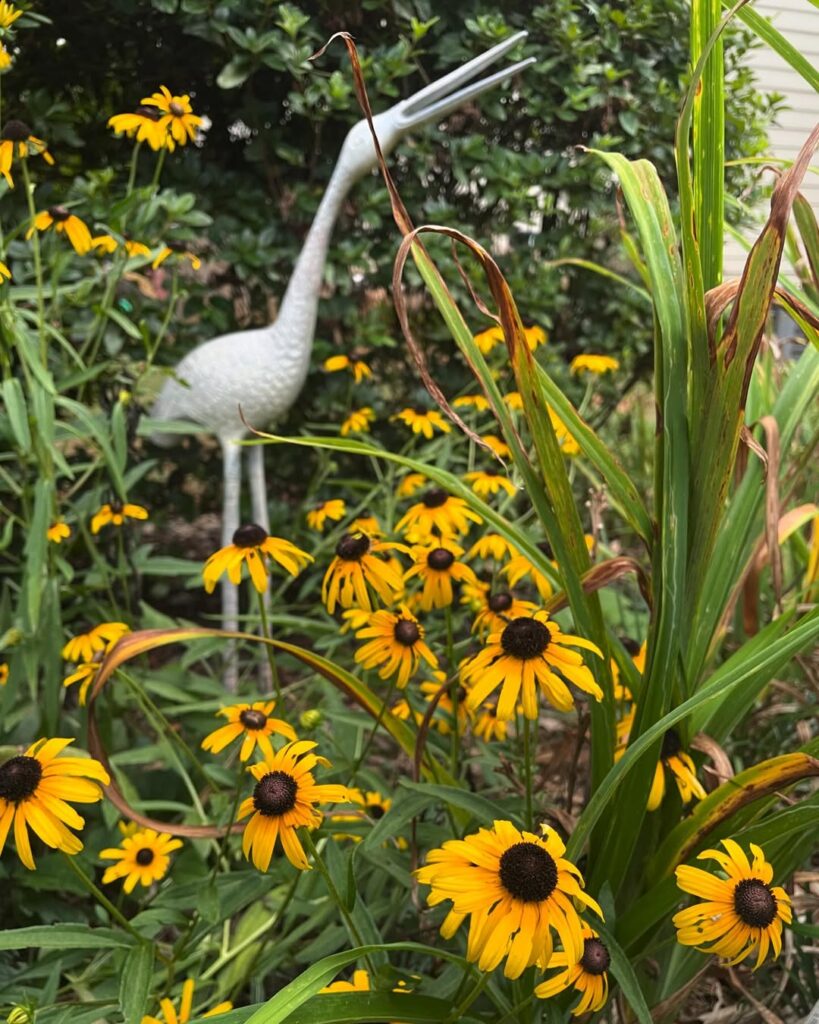
Black-Eyed Susan (Rudbeckia) is a beloved native wildflower that brings vibrant yellow blooms to New York landscapes from July through August. This adaptable plant produces classic daisy-like flowers with bright yellow petals surrounding distinctive dark central cones, reaching 1-3 feet in height with coarse, pubescent stems.
Thriving in meadows, gardens, and disturbed sites, Black-Eyed Susan serves as an excellent pollinator magnet, attracting bees, butterflies, and beneficial insects while providing seeds for birds and small mammals. The plant functions as a pioneer species, rapidly colonizing open, sunny areas and disturbed ground. Its low-maintenance nature and tolerance to New York’s variable climate make it perfect for naturalized plantings, borders, and wildflower mixes, offering long-lasting seasonal color with minimal care requirements.
- Hardiness: Annual, biennial, or short-lived perennial; tolerates New York’s variable climate
- Light: Full sun preferred; tolerates partial shade
- Water: Adaptable to dry to moist conditions; drought tolerant once established
- Soil: Well-drained substrates preferred; adaptable to various soil types
- Fertilizer: Low fertility requirements; thrives without supplemental feeding
- Pest/Disease Resistance: High resistance when grown in appropriate conditions
- Growth Rate: Moderate; establishes quickly in suitable conditions
Cardinal Flower (Lobelia Cardinalis)

Cardinal Flower is a striking native wildflower that produces brilliant scarlet blooms from late July through September. Growing 2-4 feet tall, this member of the Bellflower family thrives in wetland environments throughout New York, from the Adirondacks to various regions across the state.
This spectacular plant serves as a vital pollinator magnet, particularly for ruby-throated hummingbirds, while also attracting swallowtail butterflies and bumblebees. Though short-lived as a perennial, Cardinal Flower readily self-seeds in appropriate conditions and makes an excellent addition to woodland gardens and naturalized areas near water features. All parts of this beautiful plant are toxic in large quantities and can cause symptoms including nausea and weakness if consumed.
- Hardiness: Zones 3-9, well-suited for New York’s climate with winter mulching recommended in northern areas
- Light: Full sun to full shade, adaptable to various light conditions
- Water: High water requirements; soil must remain consistently moist to wet at all times
- Soil: Humus-rich, high organic matter soil; tolerates clay loam, sandy, limestone-based, and medium loam soils
- Fertilizer: Minimal requirements when grown in organically rich, natural soil conditions
- Pest/Disease Resistance: Generally resistant with few significant pest or disease issues
- Growth Rate: Moderate growth rate with regular self-seeding for population renewal
Wild Columbine (Aquilegia Canadensis)
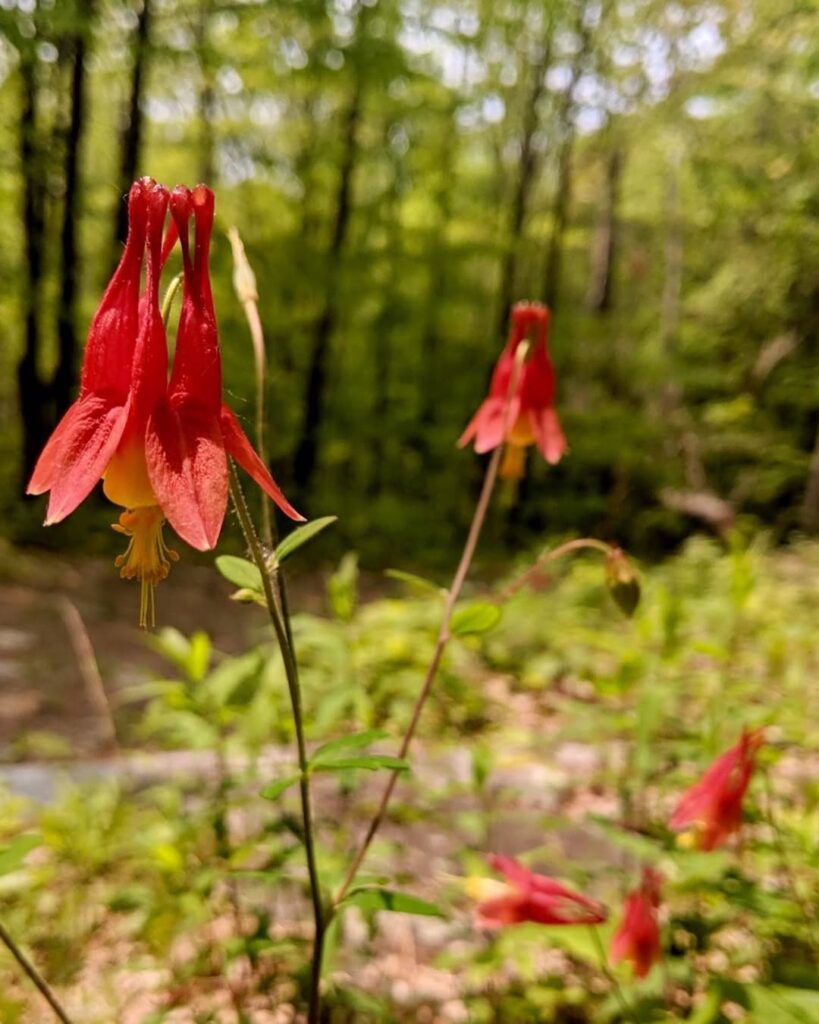
Wild Columbine (Aquilegia canadensis) is a stunning native perennial that brings vibrant red and yellow blooms to New York gardens from late spring through early summer. Growing 1-2 feet tall, this adaptable wildflower thrives in diverse conditions from shaded woodlands to sunny rock gardens. Its distinctive nodding flowers feature spurred petals that attract hummingbirds and long-tongued pollinators.
This hardy native readily self-seeds and establishes persistent populations with minimal care. Wild Columbine serves as a host plant for the Columbine Duskywing Moth and provides essential nectar for native bees and beneficial insects. The plant’s foliage is toxic to mammals, making it naturally deer-resistant in garden settings. Its tolerance for challenging sites makes it ideal for naturalistic gardens, woodland borders, and restoration projects throughout New York’s varied landscapes.
- Hardiness: USDA Zones 3-8
- Light: Full sun to partial shade; tolerates light shade
- Water: Low to moderate; drought tolerant once established
- Soil: Well-draining; thrives in loamy, rocky, sandy, or shallow soils
- Fertilizer: None required; low-maintenance native
- Pest/Disease Resistance: Generally resistant; few serious issues
- Growth Rate: Moderate; readily self-seeds for natural spread
New York’s Best Native Trees
New York boasts over 150 native tree species, from towering oaks and maples to smaller serviceberries and dogwoods, each adapted to specific growing conditions and supporting local wildlife. Following major weather events like the Labor Day Storm of 1998, forestry experts have compiled guidance on selecting resilient tree species that can better withstand environmental challenges.
Eastern Red Cedar (Juniperus)

Eastern Red Cedar is one of New York’s most adaptable native evergreens, offering exceptional versatility for landscaping needs. This medium-sized conifer reaches 30-50 feet tall with a distinctive columnar to pyramidal shape and dark blue-green foliage that may bronze in winter. Female trees produce ornamental berries that attract birds and wildlife, making it valuable for biodiversity.
Extremely hardy and low-maintenance, Eastern Red Cedar thrives in challenging conditions where other trees struggle. Its drought tolerance, salt resistance, and ability to grow in various soil types make it suitable for screening, windbreaks, and privacy plantings throughout New York landscapes. The wood is particularly valued for fence posts, furniture, and decorative carvings due to its natural durability and aromatic properties.
- Hardiness: USDA zones 2-9
- Light: Full sun
- Water: Drought tolerant once established; regular watering for ideal performance
- Soil: Adaptable to almost any soil type; high salt tolerance
- Fertilizer: Minimal requirements
- Pest/Disease Resistance: Excellent; deer resistant
- Growth Rate: Moderate
American Basswood (Tilia Americana)

American Basswood (Tilia americana) is a magnificent native deciduous tree that can reach heights of 75-130 feet with a broad, spreading canopy. Also known as American linden, this fast-growing species features distinctive heart-shaped leaves that transform into brilliant yellow fall color. The tree produces fragrant flowers in June that attract pollinators, while its seeds provide valuable food for songbirds and wildlife.
This adaptable shade tree thrives across New York State and is commonly planted in urban landscapes due to its tolerance of various soil conditions and pollution. Its pyramidal to oval shape and dense canopy make it excellent for providing substantial shade in parks, residential areas, and city streets. Beyond aesthetics, American basswood provides exceptional stormwater interception, with a single mature tree capable of intercepting over 16 million gallons annually while contributing significant energy conservation and air pollution removal benefits to urban environments.
- Hardiness: Zones 3-8
- Light: Full sun to partial shade (4-6 hours direct sunlight daily)
- Water: Moist, well-drained soil; drought tolerant once established
- Soil: Tolerates alkaline soil, clay soil, and various soil types; prefers deep, moist soils
- Fertilizer: Low maintenance; no special fertilizer requirements
- Pest/Disease Resistance: Some cultivars resistant to Japanese beetle; generally hardy
- Growth Rate: Rapid to moderate growth rate
Sugar Maple (Acer Saccharum)
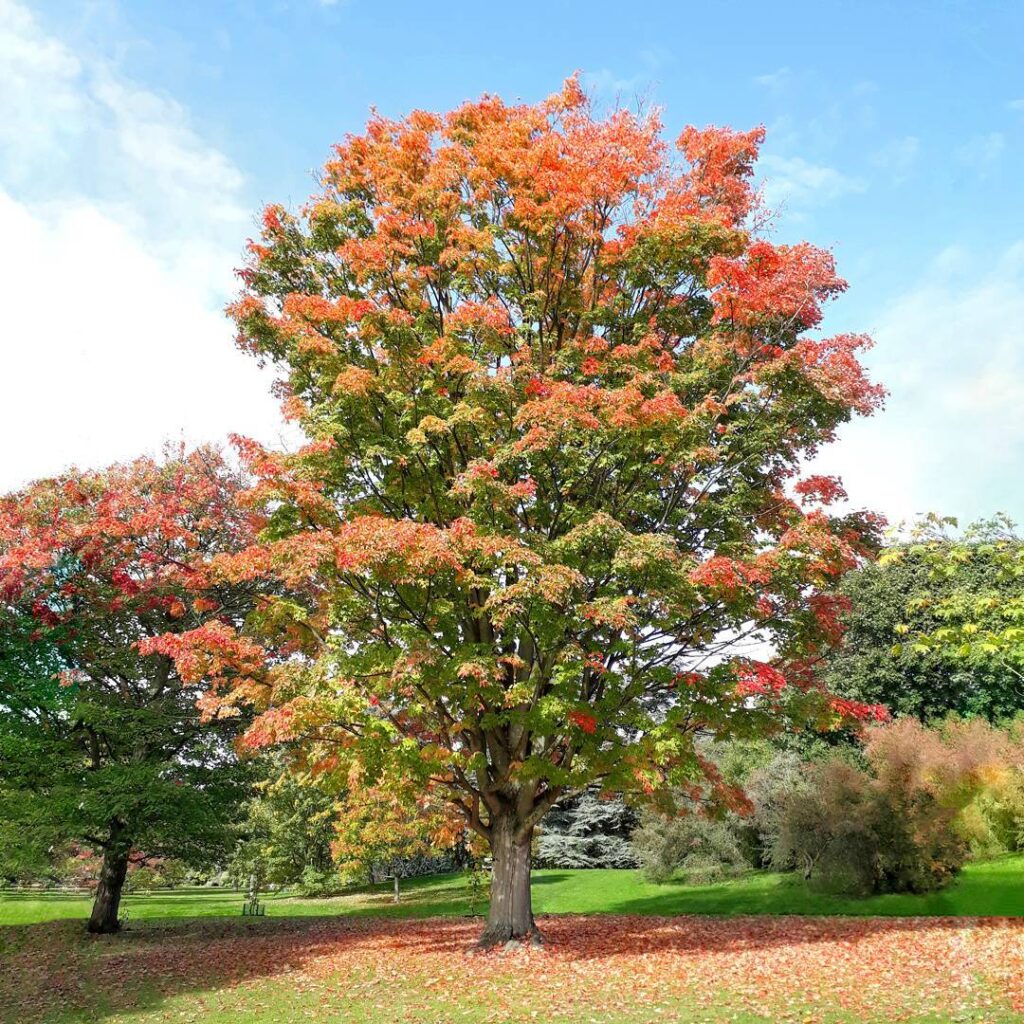
The Sugar Maple (Acer saccharum) stands as New York’s official state tree and one of the most iconic native species in the region. This majestic deciduous hardwood can reach 60-75 feet in landscape settings, living 200-300 years with proper conditions. Known for its spectacular fall display of bright red, orange, and yellow foliage, it serves multiple purposes from maple syrup production to premium lumber.
Beyond its economic value, Sugar Maple provides exceptional shade and wildlife habitat while contributing greatly to forest biodiversity. The tree’s smooth bark gradually becomes rough with age, and it produces distinctive winged seeds called samaras for reproduction. As one of the most shade-tolerant large deciduous trees, it can successfully germinate and persist even under closed canopy conditions.
- Hardiness: Zones 3-8, thrives in northeastern climate conditions
- Light: Full sun to partial shade, prefers at least 6 hours direct sunlight
- Water: Moderate moisture requirements, drought tolerant once established
- Soil: Well-drained, fertile soil; adapts to various pH levels but prefers slightly acidic
- Fertilizer: Generally unnecessary in native settings, benefits from organic matter
- Pest/Disease Resistance: Generally resistant but susceptible to maple wilt and scale insects
- Growth Rate: Slow to moderate, approximately 1-2 feet per year when young
American Elm (Ulmus Americana)

The American elm stands as one of New York’s most beloved and historically significant native trees. Known for its elegant vase-shaped form and graceful branching pattern, mature elms typically reach 60-80 feet tall with distinctive drooping branch ends that create a broad, rounded crown. Central Park’s Mall showcases one of North America’s last remaining stands of these magnificent trees.
Once devastated by Dutch Elm disease, American elms are experiencing a renaissance through disease-resistant cultivars. These majestic trees provide exceptional urban ecological benefits, improving air and water quality while reducing temperatures during hot days. Their coarse-grained, durable wood historically served various commercial purposes from barrel staves to wheel hubs. The trees’ shallow root systems make them particularly vulnerable to stress from foot traffic and urban conditions.
- Hardiness: Cold hardy, suitable for New York’s climate zones
- Light: Full sun to partial shade
- Water: Moderate to high moisture requirements; poor drought tolerance
- Soil: Rich, well-drained loam preferred; adaptable to various soil types but struggles in sandy, dry conditions
- Fertilizer: Benefits from fertile soils; supplemental feeding may improve growth
- Pest/Disease Resistance: Historically susceptible to Dutch Elm disease; newer cultivars offer improved resistance
- Growth Rate: Moderate to fast growth rate under ideal conditions
Eastern White Pine (Pinus)
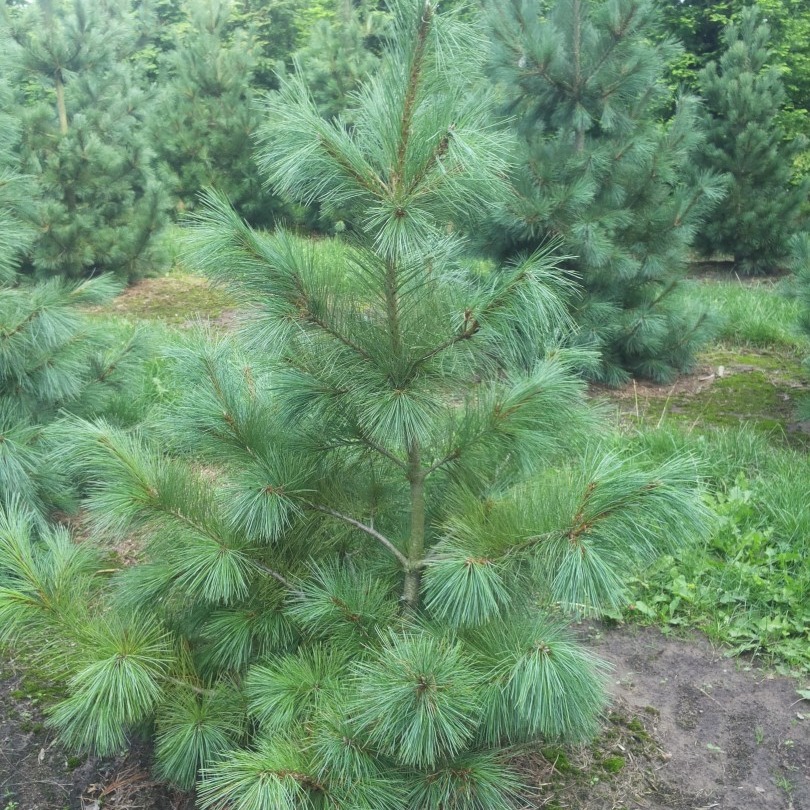
The Eastern White Pine stands as New York’s tallest native evergreen, often reaching impressive heights of 130 feet. This rapidly growing conifer is distinguished by its long, slender needles and narrow cones, making it a signature species of the Adirondack region. Historically one of the most valuable trees in eastern North America, it was prized for shipbuilding and construction due to its straight, tall trunk.
As a pioneer species, Eastern White Pine readily colonizes old fields and disturbed sites, often forming nearly pure stands when conditions are favorable. It provides critical wildlife habitat while playing an important role in soil stabilization and watershed protection. The tree’s soft needles grow in distinctive clusters of five and serve as a food source for various wildlife including snowshoe hares, which consume 25 to 50% of their winter diet from Eastern White Pine in northern New York. Today, it remains popular for reforestation projects, landscaping, and Christmas tree production.
- Hardiness: Zones 3-8, tolerates temperatures with July averages between 65-74°F
- Light: Full sun required for ideal growth; mid-tolerant to intolerant of shade
- Water: Moderate water needs; tolerates drought but requires good drainage
- Soil: Well-drained soils preferred; adaptable to sandy, loamy, and tilled soils
- Fertilizer: Low maintenance; no special fertilizer requirements
- Pest/Disease Resistance: Moderate resistance; sensitive to air pollution
- Growth Rate: Fast-growing compared to other northern forest conifers
Native Shrubs for Wildlife Habitat
Native shrubs form the backbone of wildlife-friendly landscapes, offering year-round shelter, nesting sites, and essential food sources through berries, seeds, and the insects they support. These plantings are particularly beneficial for birds, pollinators, and small mammals that depend on native vegetation for survival.
Elderberry (Sambucus Canadensis)
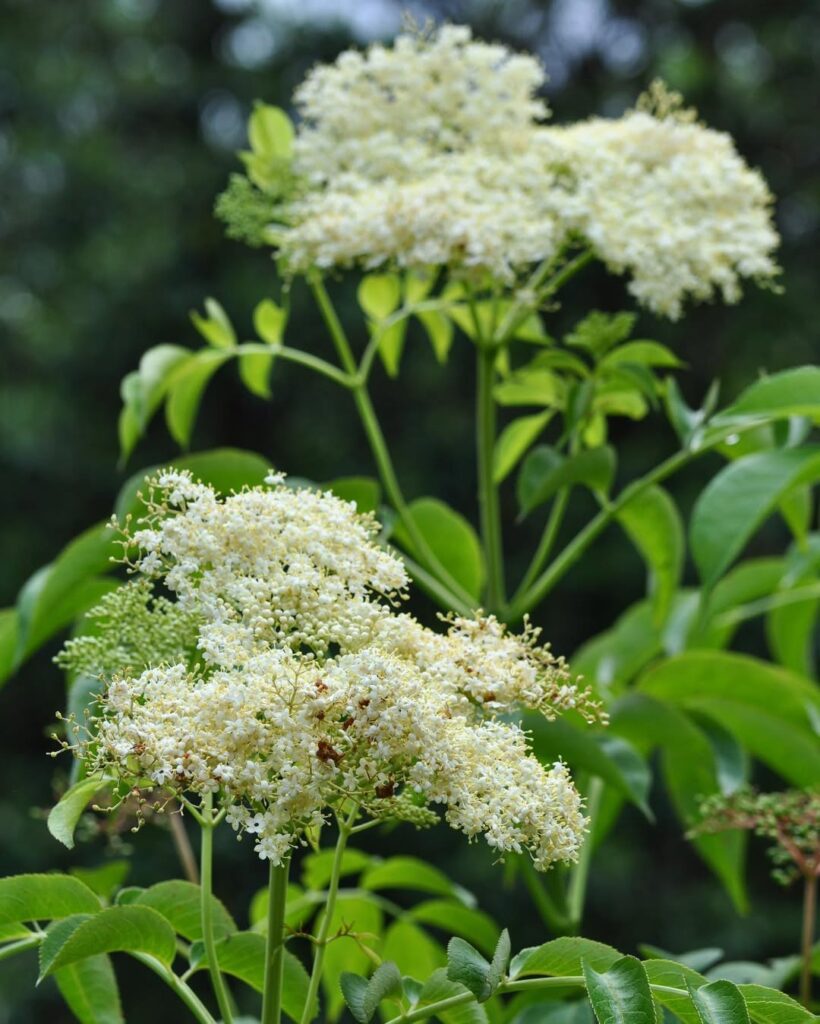
Elderberry is a versatile native shrub that typically grows 5-12 feet tall with an arching, multi-stemmed habit. This eastern North American native produces large clusters of fragrant white flowers in late spring, followed by dark purple-black berries in fall that serve as essential food for over 50 bird species.
The dense, thicket-forming growth provides excellent wildlife habitat and nesting sites while supporting pollinators during bloom time. Elderberry’s adaptability to various soil conditions and its dual ornamental and ecological value make it an exceptional choice for naturalistic landscapes, rain gardens, and wildlife-focused plantings throughout New York. The plant is also deer resistant, making it particularly valuable in areas where browsing pressure can limit other landscaping options.
- Hardiness: Native to eastern North America, well-suited to New York climate zones
- Light: Full sun to partial shade
- Water: Medium-dry to medium-wet conditions; tolerates both wet and dry soils
- Soil: Organic-rich soils preferred; tolerates wide pH range and various textures including clay, loam, and sand
- Fertilizer: Low maintenance; benefits from organic matter in soil
- Pest/Disease Resistance: Generally resistant with few serious pest or disease issues
- Growth Rate: Medium growth rate with moderate maintenance needs
Spicebush (Lindera Benzoin)
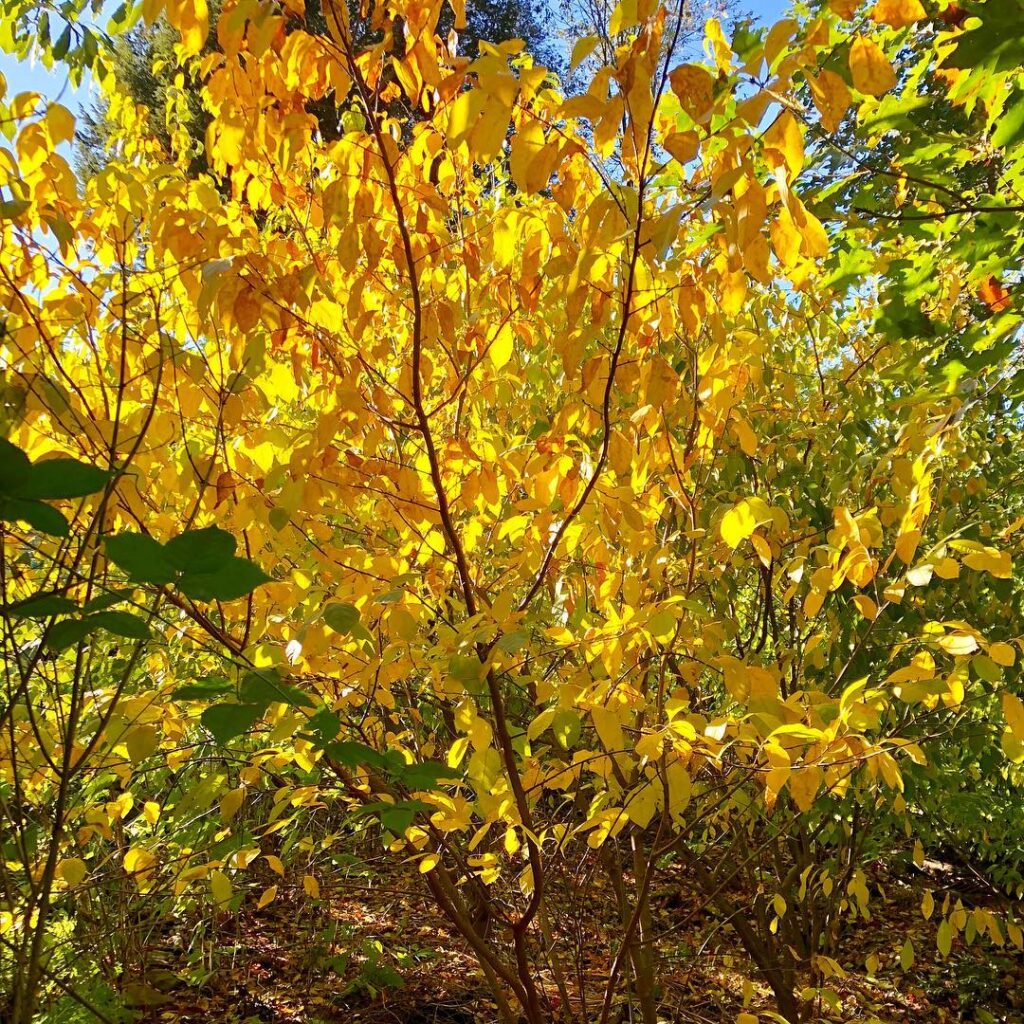
Spicebush (Lindera benzoin) is a versatile native shrub in the laurel family that serves as an excellent wildlife habitat plant for New York gardens. This aromatic deciduous shrub produces clusters of small yellow flowers in early spring before the leaves emerge, followed by bright red berries in late summer and fall. The plant offers exceptional ecological value as the host plant for spicebush swallowtail butterfly caterpillars while providing food and shelter for numerous bird species.
Reaching 6-12 feet in height, spicebush adapts well to various growing conditions from full sun to full shade, though some sunlight enhances berry production. Its golden-yellow fall foliage adds seasonal interest, while the dense branching structure provides excellent nesting sites and cover for wildlife throughout the year. The aromatic leaves and twigs can be harvested to make a flavorful herbal tea.
- Hardiness: Native to eastern North America including New York; cold hardy in local climate zones
- Light: Full sun to full shade; tolerates part shade with some sun preferred for better form and berry production
- Water: Medium water requirements; tolerates dry, moist, and wet soil conditions
- Soil: Moist, sandy, well-drained soils preferred; adapts to sandy loam and limestone-based soils
- Fertilizer: Low maintenance; typically requires no supplemental fertilization in appropriate native conditions
- Pest/Disease Resistance: Excellent; exhibits no serious disease or insect problems
- Growth Rate: Fast-growing shrub with vigorous establishment in suitable conditions
Ninebark (Physocarpus Opulifolius)
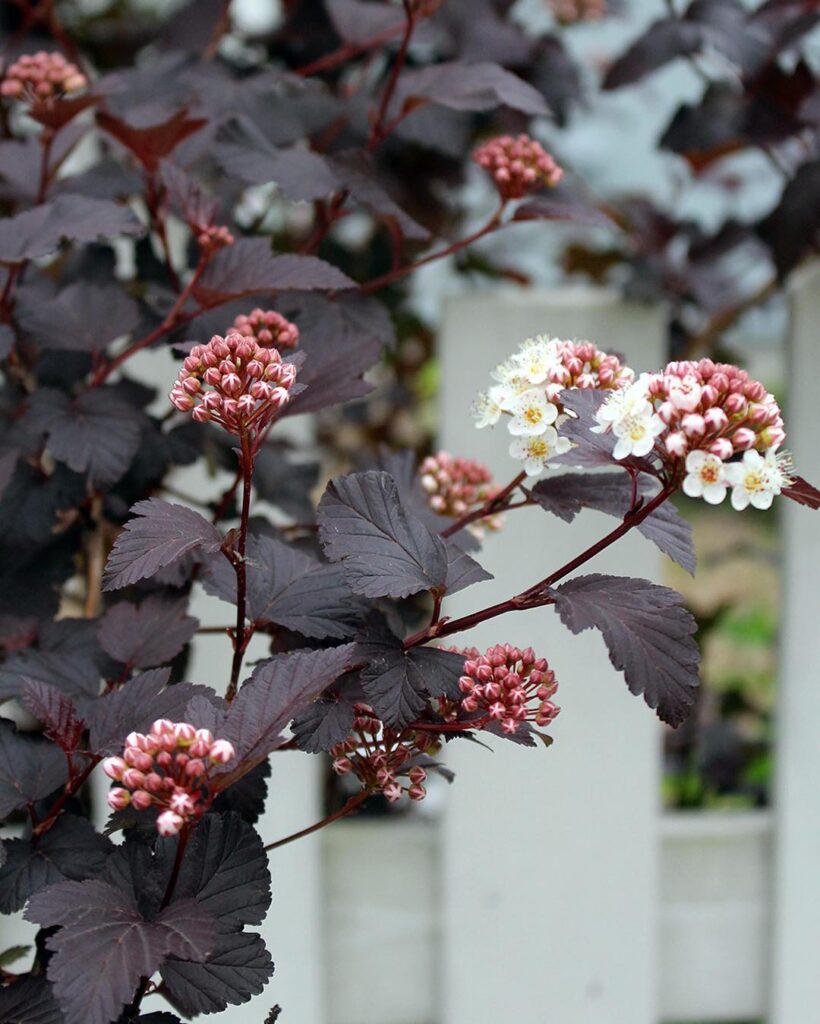
Ninebark is an excellent native shrub that brings year-round beauty and exceptional wildlife value to New York landscapes. This graceful member of the rose family grows 2-8 feet tall with distinctive arching branches and peeling brown bark that provides winter interest. In late spring, masses of delicate pinkish-white flowers create an important nectar source for bees and butterflies.
This versatile shrub thrives in diverse conditions, from stream banks to rocky hillsides, making it highly adaptable to various landscape situations. As a native alternative to invasive species like Japanese spiraea, ninebark supports local biodiversity while requiring minimal maintenance once established. The plant produces distinctive aggregated follicles that turn red or brown, adding ornamental value through fall and winter.
- Hardiness: USDA zones 3-7, well-suited to New York’s climate
- Light: Full sun to partial shade (blooms best in full sun)
- Water: Drought tolerant once established; prefers medium to moist conditions
- Soil: Tolerates various soil types including rocky, clay, and dry soils
- Fertilizer: No fertilizer needed; thrives in native soil conditions
- Pest/Disease Resistance: Generally pest and disease free with good resistance
- Growth Rate: Moderate to fast growth rate
Serviceberry (Amelanchier Canadensis)
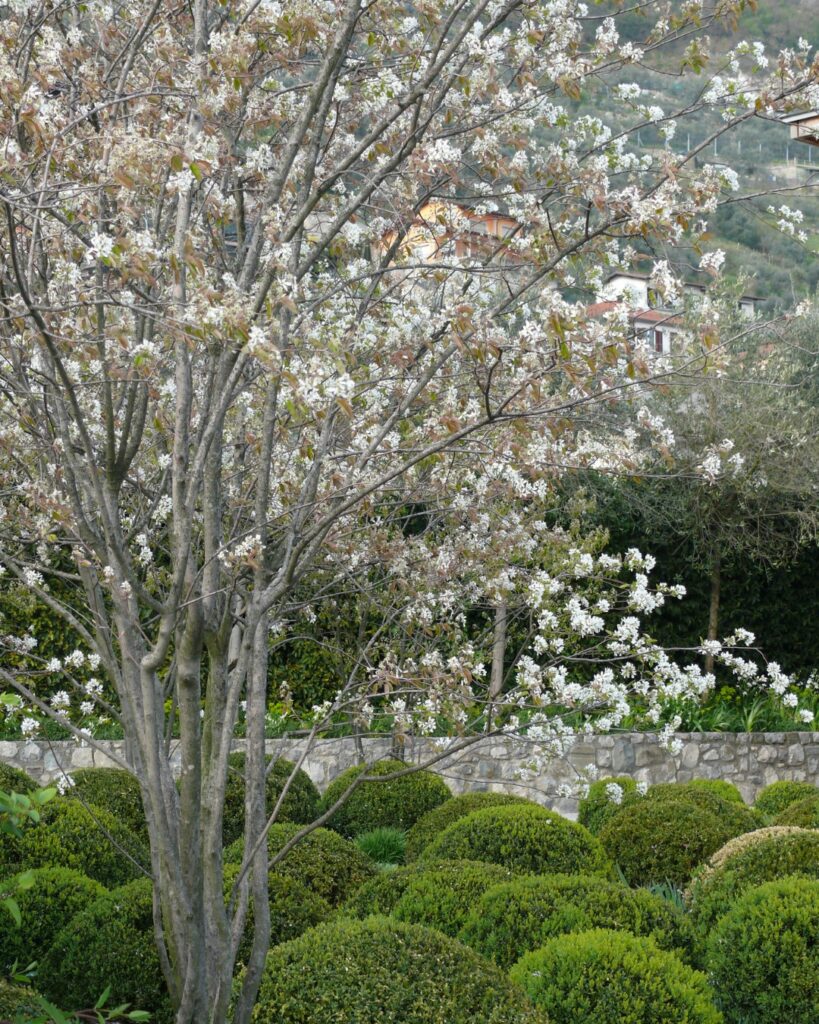
Serviceberry (Amelanchier canadensis) is a versatile native shrub that excels in New York’s diverse landscapes. Growing 15-25 feet tall with a 14-foot spread, this deciduous multi-stemmed shrub offers exceptional four-season interest. Early spring brings clusters of delicate white flowers before leaves emerge, followed by edible berries in June that attract numerous bird species. The striking gray-silver bark provides winter appeal, while vibrant orange-red fall foliage adds seasonal drama.
This low-maintenance native serves as a cornerstone species for wildlife habitat gardens. It provides essential early-season nectar for pollinators and supports butterflies like Viceroy and Red-Spotted Purple as a larval host plant. The June berries feed robins, cedar waxwings, and small mammals, while the shrub’s adaptability to various conditions makes it ideal for naturalized settings, specimen plantings, or mixed borders. The berries offer a delicious flavor profile combining strawberry and blueberry notes with a hint of almond.
- Hardiness: USDA zones 3-8
- Light: Full sun to partial shade
- Water: Moderate; drought tolerant once established
- Soil: Adaptable to wide range of soil types; well-draining preferred
- Fertilizer: Generally none required; benefits from organic mulch
- Pest/Disease Resistance: Good resistance; deer resistant
- Growth Rate: Moderate to fast
Red Osier Dogwood (Cornus)

Red Osier Dogwood is a versatile native shrub that thrives throughout New York’s diverse landscapes. Growing 3-9 feet tall, this wetland-loving plant is prized for its distinctive red stems that provide stunning winter color against snow. Dense clusters of white flowers bloom in late spring, followed by white to bluish berries that sustain wildlife through fall.
This shrub serves as an ecological powerhouse, offering critical habitat for waterfowl, songbirds, and pollinators while acting as a larval host for Spring Azure butterflies. Its extensive root system makes it invaluable for erosion control along waterways and in riparian restoration projects. The dense thickets provide excellent nesting cover and year-round browse for deer and other mammals. Red Osier Dogwood can be easily propagated through hardwood cuttings that require no special treatment, making it an accessible choice for gardeners looking to expand their native plantings.
- Hardiness: Zones 2-8, extremely cold tolerant
- Light: Partial shade to full sun, prefers part shade
- Water: Consistently moist to wet soils, drought sensitive
- Soil: Adaptable to various soil types, prefers pH 6.8-7.2, well-drained but moist
- Fertilizer: Generally not required in appropriate growing conditions
- Pest/Disease Resistance: Moderate; susceptible to twig blight, scale insects, and bagworms
- Growth Rate: Moderate to fast, spreads by suckers to form colonies
Selecting the Right Native Plants for Your Garden
How do you choose the perfect native plants when New York’s diverse landscape offers everything from sandy coastal areas to clay-heavy inland soils? Start by evaluating your specific site conditions—soil type, light exposure, and moisture levels.
Research existing plant communities in your area, as they’ll guide you toward successful plant associations. Christmas Fern thrives in shady, moist spots, while Joe Pye Weed prefers clay soils and full sun.
Plan for seasonal interest by combining plants with different bloom times. Smooth blue aster pairs beautifully with New England aster for fall color, while Christmas Fern maintains winter appeal. Native species also combat climate change through their natural adaptation to local conditions and reduced resource requirements.
Frequently Asked Questions
Where Can I Purchase Native Plants in New York?
Before you saddle up your horse, you’ll find native plants at local nurseries like Amanda’s Garden, Catskill Native Nursery, and Greenbelt Native Plant Center, plus online retailers offering delivery throughout New York.
How Much Do Native Plants Typically Cost Compared to Non-Native Varieties?
You’ll pay more upfront for native plants—typically $12-$18 versus $2.50 for non-natives. This cost comparison reflects pricing factors like limited demand and specialized production, but you’ll save considerably on long-term maintenance.
What’s the Best Time of Year to Plant Native Species?
Like nature’s perfect bookends, fall planting (September-October) and spring planting offer you ideal windows for native species. Fall’s your best bet—it allows root establishment before winter, ensuring stronger, healthier plants come spring.
Do Native Plants Require Special Fertilizers or Soil Amendments?
You don’t need special fertilizer types for native plants since they’re adapted to existing soil quality. Instead, you’ll improve clay or sandy soils with organic matter like compost, which enhances structure without synthetic nutrients.
How Long Do Native Plants Take to Establish in New Gardens?
Native plants aren’t considered established until their second summer – that’s the establishment timeline you’ll follow. Growth factors like root development happen underground first, requiring your patience and consistent watering throughout year one.
